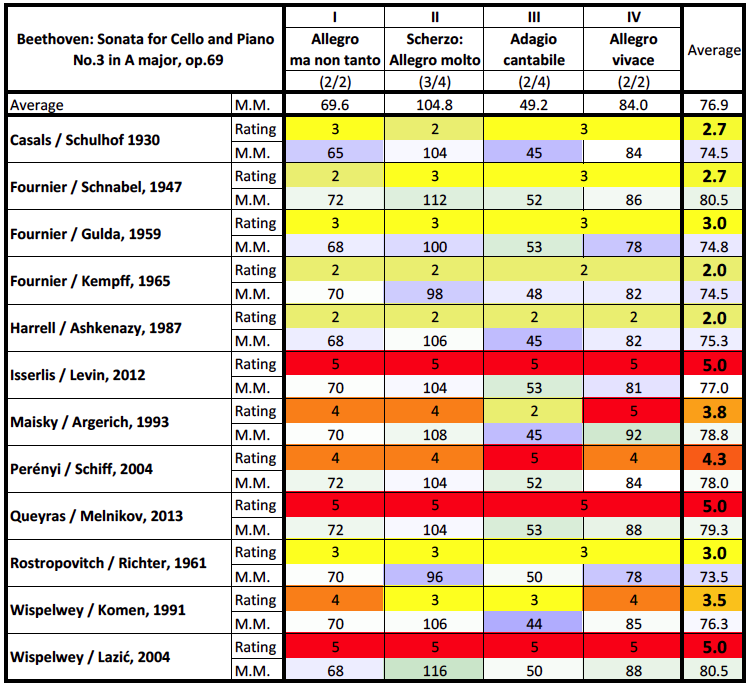Ludwig van Beethoven
Sonata for Piano and Cello in A major, op.69
Media Review / Comparison
2016-03-04 — Original posting
2016-09-30 — Brushed up for better readability
Table of Contents
- Introduction
- The Recordings
- Background, About the Composition
- The Interpretations, Overview
- The Interpretations, Detail
- Pablo Casals and Otto Schulhof (1930)
- Pierre Fournier and Artur Schnabel (1947)
- Pierre Fournier and Friedrich Gulda (1959)
- Pierre Fournier and Wilhelm Kempff (1965)
- Lynn Harrell and Vladimir Ashkenazy (1987)
- Steven Isserlis and Robert Levin (2012)
- Mischa Maisky and Martha Argerich (1993)
- Miklós Perényi and András Schiff (2001/2002)
- Jean-Guihen Queyras and Alexander Melnikov (2013)
- Mstislav Rostropovich and Sviatoslav Richter (1961)
- Pieter Wispelwey and Paul Komen (1991)
- Pieter Wispelwey and Dejan Lazić (2004)
- Conclusions
- Addendum
Introduction
This is the third note on the recordings of Beethoven’s sonatas for piano & cello in my music collection, about the Sonata in A major, op.69. References to the CDs are given at the bottom of the respective section, or see the summary on the postings covering Beethoven’s Sonatas for Piano & Violoncello.
The Recordings
Below you find my comments on the recordings that I have for the Sonata for Piano and Cello in A major, op.69 (references to the recordings are given in each section). Here’s a short list of the recordings in this comparison, in alphabetic order (last name of the cellist):
- 1930: Pablo Casals & Otto Schulhof
- 1947: Pierre Fournier & Artur Schnabel
- 1959: Pierre Fournier & Friedrich Gulda
- 1965: Pierre Fournier & Wilhelm Kempff
- 1987: Lynn Harrell & Vladimir Ashkenazy
- 2012: Steven Isserlis & Robert Levin
- 1993: Mischa Maisky & Martha Argerich
- 2001/2002: Miklós Perényi & András Schiff
- 2013: Jean-Guihen Queyras & Alexander Melnikov
- 1961: Mstislav Rostropovich & Sviatoslav Richter
- 1991: Pieter Wispelwey & Paul Komen
- 2004: Pieter Wispelwey & Dejan Lazić
Background, About the Composition
Ludwig van Beethoven (1770 – 1827) wrote his Sonata for Piano and Cello in A major, op.69 in 1808, around the time when he finished his Symphony No.5 in C minor, op.67; clearly, a composition in Beethoven’s middle period (the English Wikipedia entry is wrong in this point), neither focused on virtuosity and brilliance like the two early sonatas op.5/1 in F major and op.5/2 in G minor), nor does it show signs of the late style, such as the two sonatas op.102/1 in C major and op.102/2 in D major.
The Movements
Beethoven’s Sonata for Piano and Cello in A major, op.69 has four movements:
I. Allegro ma non tanto (2/2)
The first movement is in classic sonata form (exposition — development — recapitulation), with the exposition between repeat marks. The start of the exposition introduces the main theme, with the cello alone:
after 12 bars, the piano plays a free cadenza, in the following 12-bar segment, the roles are reverted (partially), and this time, the cadenza is in the cello part. After this, Beethoven introduces new themes / ideas; here’s the first one, in minor tonality:
the next theme / idea returns to major tonality:
and there’s another one:
II. Scherzo: Allegro molto (3/4)
The Scherzo starts with an interesting theme:
There is also a (unlabeled) Trio part that appears twice int his movement:
Of particular interest in this movement are the adjacent crotchets which are linked with a tie, but carry an explicit finger change for the second note, which can only mean that the two notes are not to be played as a syncopated half-note, but two separate, but legato crotchets — whereby it remains open / unclear whether the second note should be played as a soft echo, or with slightly less weight than the first one, or maybe even with the same weight. Some artists simply ignore the fingering instruction and play syncopated half-notes. Interestingly, the cello part does not carry staccato dots or portato bars under the tie.
III. Adagio cantabile (2/4)
The Adagio cantabile is really just an 18-bar introduction to the last movement:
Note that this section is in 2/4 time (two beats per bar, not four), which suggests a faster tempo than most players use. Also, cantabile implies that the melody in the cello should be singable, i.e., should not be too slow.
IV. Allegro vivace (2/2)
The last movement is again in sonata form (exposition with repeat marks), starting with the following, very melodic theme:
The movement ends with a fairly substantial Coda. Even though written in 2/2 (alla breve) time the movement is only playable Allegro vivace based on crotchets, i.e., like 4/4. The entire movement is very cantabile — like the first movement, with themes that are easily remembered / recognized — which makes up for the popularity of this sonata.
The Interpretations, Overview
In order to provide a rating overview, as well as an idea about tempo relations both within an interpretation, as well as between the recordings, I have prepared the table below. The color coding for the tempo (blue = slower, green = faster) refers to the average between the recordings:
Note that the metronome rates are approximate, particularly in the first movement. In the Scherzo, the metronome values were evaluated for entire bars (3/4), in the Adagio cantabile for quavers (1/8). The ratings are relative, not absolute.
The Interpretations, Detail
All of the recordings below are part of complete sets, covering all Beethoven cello sonatas; most of them also include some or all of the variation sets, two include the sonata op.17, originally written for horn and piano.
Pablo Casals and Otto Schulhof (1930)
Beethoven: The Sonatas for Cello & Piano; Variations WoO 46; Minuet in G, WoO 10/2
Pablo Casals & Otto Schulhof
Mieczysław Horszowski, Alfred Cortot
Allegro / The Great Performers, CDO 4005 (2 CDs, mono); © 2001
Booklet: 4 pp. english

Pablo Casals (1876 – 1973) made several recordings of the Beethoven cello sonatas. The above CD set features his earliest recordings, four of them (as also some of the more recent recordings) with Mieczysław Horszowski (1892 – 1993). The exception is the sonata in A major, op.69, which was recorded with Otto Schulhof (1889 – 1958). In later years, Casals also recorded the entire cycle of Beethoven sonatas with Rudolf Serkin (1903 – 1991), in live recordings from the festivals in Perpignan and Prades. Casals has also recorded some of Beethoven’s variation sets for cello and piano — these are not included with this CD set, unfortunately.
I. Allegro ma non tanto
Duration: 9’31”, exposition not repeated
Pablo Casals’ playing sounds amazingly clear and fresh in this recording! The sound of the cello is very warm and full, singing in the higher range, with a natural, well-sounding vibrato; Casals’ articulation is clear, almost modern (except maybe the occasional portamenti which are maybe a bit more prominent than what current cellists would do). The age of the recording is more obvious with the piano part: Otto Schulhof has a strong tendency towards arpeggiando playing. The piano is not tuned very well, its sound rather muffled: the recording focuses on the cello. there is also more rubato than what artists would do today, e.g., a tendency to accelerate in the recapitulation.
II. Scherzo: Allegro molto
Duration: 3’13”, central parts of the movement are left out
Less impressive than the first movement, not just because major parts of the movement are skipped (why in such a short piece?), but also because Casals seems to fall back into older esthetics, with portamento and strong accent on the second note in the tied crotchets. Here, the cello does not sound so favorably. Schulhof may be following the fingering instructions (I think he does), but this is hardly audible in this recording.
III. Adagio cantabile —
Duration: 1’46”
Played as 4/8 rather than 2/4, like Kempff / Fournier: too slow, really, and with ancient piano esthetics, all arpeggiando (much worse than Kempff, actually). But at least, Casals manages to make the melody sing strongly, even at that slow pace, through careful, beautiful, long phrases.
IV. Allegro vivace
Duration: 5’34”, exposition not repeated
Clearly, Casals is dominating, and also leading the playing, tempo-wise. Otto Schulhof manages fairly well, though occasionally he is at the limit where semiquavers start being slightly superficial. Impressive performance on the cello.
| Duration: | 20’02” |
| Recommendation: | Definitely a very valuable historic document — though more that than a listening pleasure, overall, especially considering the piano part. |
| Rating: | 2.7 (3 / 2 / 3) |
Pierre Fournier and Artur Schnabel (1947)
Beethoven: The Sonatas for Cello & Piano; Schubert: 6 Moments Musicaux op.94, D.780
Pierre Fournier & Artur Schnabel
Andromeda, ANDRCD 5108 (2 CDs, mono); ℗ 2007
Booklet: 4 pp. (track listing only)

Pierre Fournier (1906 – 1986) made several complete recordings of the Beethoven cello sonatas; this here (to my knowledge) is the earliest one, with Artur Schnabel (1881 – 1951), made 4 years after the war and 3 years before Artur Schnabel died; it does not include the variation sets.
I. Allegro ma non tanto
Duration: 11’33”
Of course, it’s a mono recording. The sound is pretty limited: the cello sounds like through a cardboard tube (I think the engineers tried to generate some stereo effect, to the detriment of the overall result). Schnabel appears to push the tempo almost throughout, one can feel “his hand” (in many parts of this movement, it is the fastest of the recordings in this comparison). Primarily, I think, one can feel Schnabel’s strong, willful concept. Fournier tries following suit, sometimes trying to hold back the tempo in order to play out his lyrical tone.
II. Scherzo: Allegro molto
Duration: 4’46”
Very dramatic in the tempo, occasionally somewhat superficial in the articulation on the piano, but at least, Schnabel observes the fingering in the tied crotchets (as much as one can tell from the recording). Fournier’s cello playing follows older esthetics, with plenty of portamento and very legato playing. Occasionally a bit pushed in the tempo, but one can feel Schnabel’s strong, consequent, dramatic concept. It may sound dated, but is still impressive.
III. Adagio cantabile —
Duration: 1’38”
Schnabel being Schnabel, he is playing without arpeggiando in general, the tempo is not too slow: Schnabel’s tempo, most likely, Fournier can’t dominate that (except for the odd portamento)…
IV. Allegro vivace
Duration: 6’37”
Again, Schnabel’s strong concept, with very good detail in articulation, consequent tempo management, rather fast, overall, but managed very well by both artists, Fournier happily appears to join in on the fast pace!
| Duration: | 24’31” |
| Recommendation: | An important historic document, but not necessarily a recording that I would recommend (unless you are a Schnabel fan), because of the oddities in the sound. At least in the interpretation, movements 2 – 4 are better than the first one. |
| Rating: | 2.7 (2 / 3 / 3) |
Pierre Fournier and Friedrich Gulda (1959)
Beethoven: The Sonatas for Cello & Piano; Variations WoO 45, 46, op.66
Pierre Fournier & Friedrich Gulda
IDG 00289 477 6266 (2 CDs, stereo); ℗ 1960 / © 2006
Booklet: 24 pp. e/d/f

12 years after the initial recording with Artur Schnabel (see above), Pierre Fournier (1906 – 1986) recorded the Beethoven sonatas again, this time with Friedrich Gulda (1930 – 2000), this time also including the three sets of variations for cello and piano.
I. Allegro ma non tanto
Duration: 12’56”
Pierre Fournier’s articulation / playing is rather romantic, with a fairly strong and relatively fast vibrato. However, the two artists are showing excellent cooperation, the recording is clear (cello on the right), not lacking transparency. Gulda’s playing is excellent, with clear, careful articulation (for its time, for sure, even though sometimes somewhat handsome), and with careful, but explicit dynamics, distinct accents. The one point one might criticize is that Fournier tends to play too loud: p is often f (such as to exhibit his singing cello tone!?).
II. Scherzo: Allegro molto
Duration: 5’22”
Also Gulda plays syncopated half notes, as far as I can tell. Like Rostropovich, Fournier gives a little accent on the second crotchet in tied pairs. But at least, the tempo is better than the slowest recordings, there is even some joking / Scherzo aspect here, especially in Gulda’s playing.
III. Adagio cantabile —
Duration: 1’38”
Again, at a good tempo (like the earlier one with Schnabel, even a tad faster). Gulda appears to keep an eye on possible romanticisms: Fournier doesn’t even play his portamento (as with the two other recordings), except for the slow transition into the last note!
IV. Allegro vivace
Duration: 7’00”
A good recording at a natural tempo, allowing for good, careful agogics and detailed articulation in the piano part: Gulda’s accompaniment is excellent, Fournier again refrains from “romantic excursions”, though occasionally he has a slight tendency to accelerate. His articulation in general is not exactly historically informed, but singing and more than just OK in general.
| Duration: | 26’56” |
| Recommendation: | A fairly good recording, with both artists at the height of their career and abilities. |
| Rating: | 3.0 (3 / 3 / 3) |
Pierre Fournier and Wilhelm Kempff (1965)
Beethoven: The Sonatas for Cello & Piano; Variations WoO 45, 46, op.66
Pierre Fournier & Wilhelm Kempff
DG 453 013-2 (2 CDs, stereo); ℗ / © 1966
Booklet: 28 pp. e/d/f/i/sp

Finally, another 6 years later, Pierre Fournier (1906 – 1986), made yet another complete recording of Beethoven’s sonatas and variations for Cello and piano. This time, Fournier played with Wilhelm Kempff (1895 – 1991). The recording label (Deutsche Grammophon) also included this recording in their big Beethoven edition (70 LPs) on the occasion of the composer’s 200th birthday.
I. Allegro ma non tanto
Duration: 9’10”, exposition not repeated
Kempff shows ph(r)ases with good, detailed articulation, but also sections where he is rather coarse, not very careful in dynamics; I prefer Fournier’s recording with Friedrich Gulda, where both artists sound more in tune and more detailed.
II. Scherzo: Allegro molto
Duration: 5’36”
Taken as “proper 3/4 time” the tempo is fast (1/4=ca. 290), but as the music feels in entire bars, this feels rather comfortable, relaxed, rather than Allegro molto. In the course of the movement, the tempo even slows down. The tied crotchets sound almost as if played as syncopated half notes (if one listens very carefully, one may hear weak echo notes). The playing otherwise is clean, the cello singing (with plenty of vibrato, though), but not very exciting, overall, maybe playful, but not joking / Scherzo-like.
III. Adagio cantabile —
Duration: 1’42”
In combination with an already slow tempo, Kempff’s amount of permanent legato playing is irritating, if not almost obnoxious. Fournier complements this with a prominent vibrato and a strong portamento in bar 8, and (unnecessarily) on the last fermata. Esthetics of a past time!
IV. Allegro vivace
Duration: 5’24”, exposition not repeated
Some of the semiquaver scales in the right hand and on the cello are somewhat superficial, some passages slightly rushed. But still a lively interpretation in general. The ending is too broad, with an unwritten ritardando.
| Duration: | 21’52” |
| Recommendation: | I can’t recommend this recording. It reflects past esthetics. No, it’s not thoroughly bad, but there are so many better ones! |
| Rating: | 2.0 (2 / 2 / 2) |
Lynn Harrell and Vladimir Ashkenazy (1987)
Beethoven: The Sonatas for Cello & Piano
Lynn Harrell & Vladimir Ashkenazy
Decca / London 417 628-2 (2 CDs, stereo); ℗ / © 1987
Booklet: 39 pp. e/f/d

Lynn Harrell (1944 – 2020) recorded the Beethoven sonatas (without the variations) with Vladimir Ashkenazy (*1937); these recordings (1987) were first released on LP.
I. Allegro ma non tanto
Duration: 13’41”
Unfortunately, the sound of this recording is not very clear, somewhat muffled for both instruments, lacking transparency, the tempo in the introduction very static, rather slow the artists switch to a more fluent pace after the cello cadenza. The piano articulation is only really audible where the piano sounds alone. A good, correct interpretation, not much more
II. Scherzo: Allegro molto
Duration: 5’10”
Syncopated half notes rather than tied crotchets, but instead, Harrell puts a clear accent on the second crotchet, wherever this applies, defeating the syncope character of his part. The articulation is rather short (not light!), almost harsh at times.
III. Adagio cantabile —
Duration: 1’47”
Extremely slow (as if it was written in 4/8 time, rather than 2/4), too slow to be cantabile (singable), static.
IV. Allegro vivace
Duration: 6’51”
Semiquaver passages (e.g., bar 16ff. in the piano, or the cello scales in the second theme) tend to accelerate. No idea why Harrell decided to play the semiquavers in bars 18/19 (each bar under a slur) détaché rather than legato: that sounds rather odd. Ashkenazy’s accompaniment is OK, apart from the odd tendency to accelerate; the cello articulation is often very mellow.
| Duration: | 27’28” |
| Recommendation: | Definitely not my favorite. Actually, this is one of the least favored recordings among the non-historic recordings. |
| Rating: | 2.0 (2 / 2 / 2 / 2) |
Steven Isserlis and Robert Levin (2012)
Beethoven: The Sonatas for Cello & Piano, incl. op.17; Variations WoO 45, 46, op.66
Steven Isserlis & Robert Levin
hyperion CDA67981/2 (2 CDs, stereo); ℗ / © 2014
Booklet: 24 pp. e/f/d

This is a recent recording, with Steven Isserlis (*1958), accompanied by Robert Levin (*1947). Isserlis plays a cello by Stradivarius, “Marquis de Corberon”, from 1726, and a Tourte bow. Levin plays a fortepiano by Paul McNulty — a replica after an instrument by Walter & Sohn from around 1805. The recording also includes the three sets of variations (op.66, WoO 45 and 46), as well as the sonata op.17, originally written for horn and piano.
I. Allegro ma non tanto
Duration: 12’35”
This recording directly competes with Pieter Wispelwey’s early historically informed recording from 1991 (with Paul Komen). It beats it in several aspects: the sound (recording technique) is clearly better, the cello sound is more round & full, the fortepiano is a Walter replica and indeed the “right” instrument for this period, with a more differentiated, more refined tone, lighter / slimmer, but more colorful in the bass register, more singing in the descant: the Broadwood has more volume and a larger tonal range, but that does not profit a CD recording, maybe not even chamber music from Beethoven’s middle period in general.
Yes, one does note that the keyboard mechanics on the Walter are less precise than on the Broadwood (e.g., making it harder to play a scale as evenly as on modern instruments). However, that just makes for a more lively, more “living” sound and recording! Also, the HIP playing has progressed here: Isserlis does use a slightly bigger (& justified) amount of vibrato. When they repeat the exposition, both artists deviate from strictly playing what’s in the score, but they add a few extra ornaments, and the alter the cadenzas, rather than playing the same ones again. I find that refreshing & interesting!
It’s a really excellent recording, overall! Occasionally I’d wish for the fortepiano to be a tad more in the foreground, as Isserlis’ Strad (a truly beautiful instrument!) has never any problem making itself heard. It overall brings more volume than the fortepiano — but if that is the historic reality. One last detail: in the tumultuous phase in the development section, this recording clearly is the most dramatic and colorful of all in this comparison.
II. Scherzo: Allegro molto
Duration: 5’24”
The tempo is moderate, but thanks to a very lively and detailed articulation, the tempo still feels Allegro molto. Very clean, articulate playing, and of course, the fingering instructions are clearly followed, their effect obvious (and the Walter fortepiano makes this easily audible). Nice and clean distinction in character between the Trio and the Scherzo parts. Unlike the Broadwood instrument (in Pieter Wispelwey’s / Paul Komen’s recording below), the Walter fortepiano has proper, functioning dampening: obviously the right choice of instrument for this sonata, even irrespective of its rich, colorful sound!
III. Adagio cantabile —
Duration: 1’31”
Excellent! Definitely superior to Wispelwey / Komen, in the cello part absolutely comparable to Wispelwey’s newer recording, or to Queyras, though with more freedom on letting vibrato evolve on long notes. But the recording is hard to beat in combination with the Walter fortepiano: the brighter sound of the period instrument (replica) gives this movement a simpler feel, more colors, while not being intrusive on the cello part.
IV. Allegro vivace
Duration: 7’28”
Again very nice: I like the lively sound, articulation and dynamics in the fortepiano, the use of the moderator for the p/pp staccato sequences in the middle of the exposition (and equivalent pp segments later on). Nice, distinct agogics, and the beautiful, rich & warm sound of Steven Isserlis’ Strad: pure joy and pleasure!
| Duration: | 26’58” |
| Recommendation: | One of three top recordings, and of course my personal favorite (given my preference for historically informed interpretations). If you are not familiar with the fortepiano: why don’t you take the plunge with this recording? You won’t regret it! |
| Rating: | 5.0 (5 / 5 / 5 / 5) |
Mischa Maisky and Martha Argerich (1993)
Beethoven: The Sonatas for Cello & Piano; Variations WoO 45, 46, op.66
Mischa Maisky & Martha Argerich
DG 453 748-2 (2 CDs, stereo); ℗ 1991/93 / © 1997
Booklet: 46 pp. e/d/f

In 1991 and 1993, Mischa Maisky (*1948) and Martha Argerich (*1941) made their recordings of all Beethoven cello sonatas, including the three sets of variations, op.66, WoO 45 & WoO 46. For many, this is a reference recording, similar to the one with Rostropovich / Richter (see below).
I. Allegro ma non tanto
Duration: 12’40”
The base pace is relatively fluent, particularly in the introduction; throughout the movement, the artists have a clear, distinct (and lively) tempo concept, and they use decent agogics. Excellent duo playing, excellent in the cello, brilliant and vivid in Martha Argerich’s piano part: virtuosic, clear, with her typical, extreme presence, lively dynamics and articulation, overall clarity: I like it, even though some now may find it at the border of being too “active”.
II. Scherzo: Allegro molto
Duration: 5’02”
Very lively and dramatic (typical of Argerich), certainly with Scherzo character (to a slightly lesser degree also in the Trio-like parts). The main downside is that the fingering instructions on the tied crotchets are ignored pretty consequently: both artists simply play syncopes (with very rare exceptions on the piano).
III. Adagio cantabile —
Duration: 1’59”
Very slow — too slow for my taste: the melody far too long and hard to follow. Argerich only evades boredom by adding arpeggiando playing, fairly strong vibrato in the cello: old(er) style esthetics?
IV. Allegro vivace
Duration: 6’33”
In contrast, this movement is extremely lively, vivid, virtuosic, even spectacular—whatever everybody likes about Argerich’s playing! Also the cello uses light articulation (and moderate vibrato). Excellent duo playing, of course. The one part where other pianists are competing with or beating Argerich is in “Klangrede”, in small-scale agogics and maybe more detailed and explicit articulation.
| Duration: | 26’14” |
| Recommendation: | An excellent recording almost throughout. As mentioned: for many (not just the Argerich fan community) it is still a reference. |
| Rating: | 3.8 (4 / 4 / 2 / 5) |
Miklós Perényi and András Schiff (2001/2002)
Beethoven: The Sonatas for Cello & Piano, incl. op.17; Variations WoO 45, 46, op.66
Miklós Perényi & András Schiff
ECM New Series 1819/20 (2 CDs, stereo); ℗ / © 2004
Booklet: 28 pp. d/e

Here’s another complete recording of all sonatas, including the three sets of variations, op.66, WoO 45 & WoO 46, as well as the sonata op.17, originally written for horn and piano: the Hungarian pianist András Schiff (*1953) is accompanying his compatriot Miklós Perényi (*1948), in a recording from 2001/2002.
I. Allegro ma non tanto
Duration: 11’35”
A very “spacious” recording with lots of reverberation—too much, I think. Strangely, the tempo often sounds slightly pushed / rushed (sure, it’s an Allegro, but not so much). Schiff’s playing is careful, but not as detailed, particularly in agogics and articulation, asLazić or Melnikov (or Argerich), however, his dynamic balance between the hands / voices, the transparency, the audibility and articulative detail of the voice(s) in the left hand are truly outstanding and exemplary (without sounding “ex cathedra”, for once). Perényi’s cello sound is excellent, the vibrato natural, mostly unobtrusive.
II. Scherzo: Allegro molto
Duration: 5’12”
Mostly, Schiff plays the tied crotchets correctly, though initially, it sounds rather as if the second crotchet was muted. On the other hand, where tied crotchets are played “solo”, the echo note can be heard clearly. Perényi also places a little accent on the second note. Overall, it’s a rather dramatic interpretation, often ff rather than f—too dramatic in lieu of a joking Scherzo?
III. Adagio cantabile —
Duration: 1’31”
Excellent, fluent tempo, never overblown, but simple in articulation and attitude, very little vibrato, very natural playing, like a Lied—very good, indeed!
IV. Allegro vivace
Duration: 6’48”
Very good duo playing, careful articulation, maybe a bit too loud (not p) in the semiquaver section in bars 16ff. and equivalent passages. The dynamics tend to be a bit expansive, in my opinion. Excellent cello playing, for sure, with limited vibrato, carefully following the notation in every slur. The same goes for the piano, except, as mentioned, some of the dynamics are a bit too articulate.
| Duration: | 25’04” |
| Recommendation: | Excellent recording in general—among the best in recent times, certainly worth a recommendation, even though not at the very top for me. |
| Rating: | 4.3 (4 / 4 / 5 / 4) |
Jean-Guihen Queyras and Alexander Melnikov (2013)
Beethoven: The Sonatas for Cello & Piano; Variations WoO 45, 46, op.66
Jean-Guihen Queyras & Alexander Melnikov
Harmonia mundi HMC 902183.84 (2 CDs, stereo); ℗ 2014
Booklet: 20 pp. f/e/d

This latest recording of the Beethoven cello sonatas, including the three variation sets op.66 as well as WoO 45 and WoO 46, features two artists who have gained highest reputation in recent years, the cellist Jean-Guihen Queyras (*1967) and the Russian pianist Alexander Melnikov (*1973). Queyras was solo cellist in the Ensemble Intercontemporain, where he explored modern music. He has since successfully launched a solo and recording career. Melnikov is excellent both as solo pianist as well as in accompaniment (just consider his excellent recording of Beethoven’s sonatas for piano and violin with Isabelle Faust!). Queyras plays a cello by Gioffredo Cappa from 1696, Melnikov plays a modern concert grand.
I. Allegro ma non tanto
Duration: 12’13”
An excellent recording, of the same class as Wispelwey & Lazić, with Queyras using even less vibrato, sometimes none at all. Melnikov is a top-class pianist for this repertoire, extremely careful and detailed in articulation, agogics and dynamics; both artists (especially Queyras) appear unpretentious. The tempo is fresh, among the fastest here, though with very distinct agogics. Clearly, these artists play a sonata for piano and cello (as Beethoven’s title suggests), not for cello and piano. Queyras never tries playing himself into the foreground, the lead (in dynamic balance) is left to the piano. I only have one very minor reservation: Queyras occasionally has a very slight tendency to play belly notes…
II. Scherzo: Allegro molto
Duration: 5’08”
Very clean in articulation, the fingering changes in the tied crotchets are audible as echo, yet the notes are clearly tied (wouldn’t know how to execute this any better!). Queyras imitates that articulation perfectly—excellent, clear playing overall, good tempo; a true Scherzo, not just elegant and/or playful: simply very, very good!
III. Adagio cantabile —
Duration: 1’33”
With less explicit agogics than Wispelwey / Lazić (see below), but nevertheless on a par with that recording (using a very similar tempo, in general), with the very restrained cello tone and vibrato: cantabile, but not trying to overstate that with excess volume and tone. It is also similar in the little cadenza at the transition (going down to a whispering pppp!): very good! Also Melnikov’s playing is very simple, natural, never obtrusive—perfect mutual adaptation!
IV. Allegro vivace
Duration: 6’36”
Again excellent, lively and vibrant, “speaking” in every detail, while at the same time remaining very sincere to the score. Very nice detail: the small variations (& extra ornaments) in the repeat of the exposition. Lively agogics, and an excellent, distinct tempo concept: I like every detail of this recording!
| Duration: | 25’30” |
| Recommendation: | My second top favorite with a modern piano, along with Wispelwey / Lazić — definitely strongly recommended! |
| Rating: | 5.0 (5 / 5 / 5) |
Mstislav Rostropovich and Sviatoslav Richter (1961)
Beethoven: The Sonatas for Cello & Piano
Mstislav Rostropovich & Sviatoslav Richter
Philips 412 256-2 (2 CDs, stereo); ℗ 1963
Booklet: 11 pp. e/d/f

This early reference performance (the first one that I had on LP) from 1962 featured the Russian artists Mstislav Rostropovich (1927 – 2007) and Sviatoslav Richter (1915 – 1997) at the height of their abilities, the recordings were made by Philips in Vienna and London (op.69); the variation sets and op.17 are not included (one can also find video recordings from the Edinburgh Festival from around the same time).
I. Allegro ma non tanto
Duration: 12’01”
Excellent playing on both parts, technically and in coordination / ensemble playing. However, time has moved on, this recording is showing signs of age. Rostropovich uses a fairly strong and omnipresent vibrato, Richter’s playing is way less differentiated than, e.g., Melnikov’s, Argerich’s or Lazić’s. Occasionally, Richter uses a lot of pedal. Actually, the recording is less differentiated overall (why does Richter leave out some of the trills?). In comparison, it sometimes almost sounds superficial. Sure, it is technically brilliant, virtuosic—but lacking detail, in comparison. And, of course, the sound can’t compete with some of the recent recordings.
II. Scherzo: Allegro molto
Duration: 5’33”
For all I can tell, Richter plays syncopated half notes rather than tied/echoed crotchets (interestingly, Rostropovich tends to put a little accent on the second crotchet!). Apart from that, of course expressive, played with technical perfection, but at a tempo that feels too comfortable, devoid of Scherzo character.
III. Adagio cantabile —
Duration: 1’29”
Rostropovich’s vibrato is strong, but natural, and fairly omnipresent. Maybe occasionally his playing is close to feeling overblown. The tempo is fluent (among the faster in this comparison) and certainly does not feel too slow. Richter’s accompaniment is simple, unpretentious.
IV. Allegro vivace
Duration: 7’02”
Also here, Richter’s accompaniment is excellent and carefully articulated, though maybe not as detailed and “talking” as newer recordings. He plays with natural virtuosity, never pretentious or obtrusive, excellent ensemble playing. There is a strong build-up in the development part, also in the recapitulation section and in the Coda, with a slight tendency to accelerate in these build-ups.
| Duration: | 26’05” |
| Recommendation: | This certainly used to be a reference recording (for many it may still be one!), but to me, it starts to show signs of age (especially in the cello esthetics), but in general, it remains a good, solid interpretation. |
| Rating: | 3.0 (3 / 3 / 3) |
Pieter Wispelwey and Paul Komen (1991)
Beethoven: The Sonatas for Cello & Piano
Channel Classics CCS3592 (2 CDs, stereo); ℗ / © 1992
Booklet: 20 pp. e/nl/d/f

Pieter Wispelwey (*1962) recorded the Beethoven cello sonatas twice; this is the earlier recording, covering the sonatas only (not the variations or op.17), with Paul Komen playing a historic Broadwood fortepiano from 1823 (the same instrument model that Beethoven received from Broadwood in 1818 as a gift, on behalf of Muzio Clementi). Wispelwey plays a Cello by Barak Norman from 1710.
I. Allegro ma non tanto
Duration: 13’00”
Clearly, the “historic approach”, with the cello being played with very little vibrato, often none at all. The Broadwood fortepiano is an excellent instrument, famous at its time. Broadwood pianos are known to sound a bit gross (if I remember correctly), which this recording actually confirms. It’s not a replica, but a historic instrument in excellent condition, as far as I can tell from this recording. One should note, though, that at Beethoven’s time, fortepiani were undergoing rapid development. So, this instrument from 1823 is a “bit too late”. A Walter of Graf model would have been more appropriate for a sonata from 1808. So, in a way, this recording is somewhat of a compromise.
One notes that the dampers on the Broadwood have very limited effect: the strings are not entirely muted immediately. The interpretation is nice, though, but it has somewhat of a “woodcut” sound, overall. Also the recording technique has improved over the past 25 years. Still, in terms of transparency and acoustic balance (within the piano part, but also between cello and piano), this recording can easily compete with or beat the best recordings with a modern concert grand. The articulation on the piano is detailed and very good. In current HIP terms, Wispelwey’s playing is maybe a bit extreme (e.g., in the scarcity of vibrato and the roughness of the sound). This may be the reason why the artist re-recorded the Beethoven sonatas 13 years later…
II. Scherzo: Allegro molto
Duration: 4’57”
The lack of proper muting on the Broadwood is not so favorable for this movement, as there are no proper rests. Also, the tempo is maybe a little too fast, as some of the piano articulation (acciaccaturas) is slightly superficial. Occasionally, the playing sounds slightly rushed / pushed. As for the tied crotchets: mostly, one cannot hear the effect of the fingering annotation. In the few cases where that voice is alone, the second crotchet sound like mute rather than played.
III. Adagio cantabile —
Duration: 1’55”
I like the simple cello tone, with limited vibrato. Unfortunately, the movement is way too slow (the slowest in this comparison) and very static, making the melodies extremely long — too long, beyond recognition, really. Even the Broadwood fortepiano can’t inspire this to more live.
IV. Allegro vivace
Duration: 7’04”
The introduction may be flat, but here, the fortepiano definitely helps with better balance and transparency. Very detailed in the articulation. The fortepiano occasionally sounds slightly vulgar. There are a few rests where the limited effect of the dampers has a negative impact.
| Duration: | 26’56” |
| Recommendation: | An early recording of type “historically informed” — good, but not perfect, mainly due to limitations with the Broadwood fortepiano (understandable that Pieter Wispelwey wanted to try again after a few years!). |
| Rating: | 3.5 (4 / 3 / 3 / 4) |
Pieter Wispelwey and Dejan Lazić (2004)
Beethoven: The Sonatas for Cello & Piano; Variations WoO 45, 46, op.66
Pieter Wispelwey and Dejan Lazić
Channel Classics CCS SA 22605 (2 CDs, stereo); ℗ / © 2005
Booklet: 20 pp. e/nl/f/d

In his more recent recording from 2004, Pieter Wispelwey (*1962) is playing a cello by Guadagnini. He opted for an accompaniment on a modern piano, played by Dejan Lazić (*1977). On the other hand, this recording now also includes the three variation sets, op.66, as well as WoO 45 and WoO 46.
I. Allegro ma non tanto
Duration: 12’48”
A completely different interpretation than, e.g., Argerich & Maisky: not aiming at virtuosity, but very careful and detailed in articulation, dynamics and agogics. It features excellent duo playing, mutually adapted—an interpretation in a single mold: the sound is excellent, and Wispelwey’s vibrato very limited (never obtrusive) and selective, simply excellent! Also the recording sound / transparency leaves very little, if anything to wish for.
II. Scherzo: Allegro molto
Duration: 4’46”
As fast as Fournier/Schnabel, overall: feels fast, but not rushed, featuring excellent, detailed articulation on both parts. Dejan Lazić’s articulation is so clean / “sharp” that the fingering in the tied crotchets can’t barely be heard when there is a chord in the left hand, but of course, he does follow the notation. Simply excellent playing on both parts, and maintaining the Scherzo character, dramatic, but not overblown.
III. Adagio cantabile —
Duration: 1’42”
The very start is fairly slow, but that turns out to be just the first notes. Even in that short movement, these artists use very distinct (and very nice, “talking”) agogics. Wispelwey’s use of vibrato is absolutely exemplary: used for highlighting, not spreading “vibrato sauce” everywhere! The ensemble playing is perfectly “in tune”. The short cadenza at the transition is simply perfect, stunning in its ability tu build up tension towards the final movement — can this be done any better?
IV. Allegro vivace
Duration: 6’36”
The articulation in the cello is lighter than Perényi’s. Agogics and phrasing are definitely richer in both parts, the dynamics less “ex cathedra”. The interpretation never rushed, even though the tempo in the development part is fairly high — simply excellent!
| Duration: | 25’50” |
| Recommendation: | Clearly among my top favorites and definitely a recommendation (despite the modern piano!) |
| Rating: | 5.0 (5 / 5 / 5 / 5) |
Conclusions
I have three clear favorites:
- Steven Isserlis & Robert Levin (2012, HIP)
- Jean-Guihen Queyras & Alexander Melnikov (2013, modern piano)
- Pieter Wispelwey & Dejan Lazić (2004, modern piano)
For historic references you may want to look into
- Pablo Casals & Otto Schulhof (1930)
- maybe also Pierre Fournier & Friedrich Gulda (1959)
And for a more traditional approach or other good recordings see
- Mischa Maisky & Martha Argerich (1993)
- Miklós Perényi & András Schiff (2004)
- Mstislav Rostropovich & Sviatoslav Richter (1961)
Addendum
I’m using pocket scores (Lea Pocket Sores, Kalmus or Eulenburg) to follow this music while listening. —Find pocket score on amazon.com (#ad) —



































